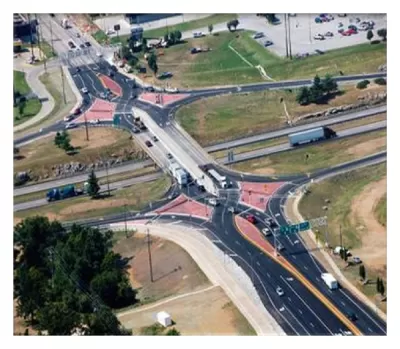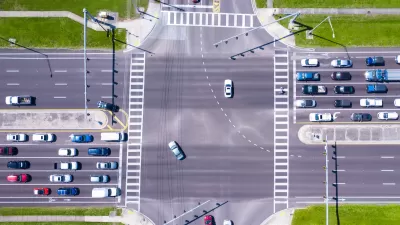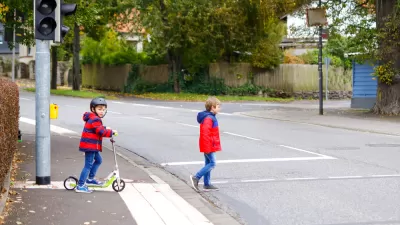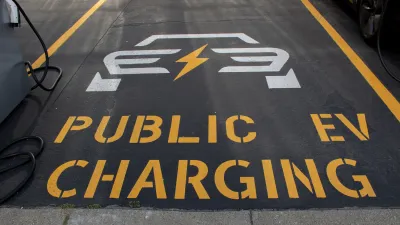The unusual design improves traffic flow and reduces the danger of head-on collisions as cars enter the I-5 freeway.

If you've ever wondered what it's like to drive on the left side of the road, you can now experience it in Washington State. The "diverging diamond" interchange in Laceyopened in August of 2020, with final touches scheduled to be completed early this year. The design, writes Mike Lindblom in the Seattle Times, reduces possible collision points by nearly half and speeds up the time it takes drivers to reach the I-5 freeway. Putting cars on the left side eliminates the need for a traffic light as drivers turn left to enter the freeway and eases the flow of traffic. According to Blake Knoblauch, executive director of the Lacey South Sound Chamber of Commerce, "drivers who previously waited through two or three light cycles now usually make it through on the first green light."
Popularized by Gilbert Chlewicki of Advanced Traffic Solutions, the diverging diamond interchangeis slowly picking up steam in the United States, with around 150 constructed to date. A study of the design that analyzed 26 such interchanges found that the number of collisions declined by 37%, with the number of injury crashes falling by more than 50%.
The interchange takes a bit of getting used to for some drivers, who fear getting hit or have trouble reaching the appropriate lane for entering the freeway. Bicycling conditions "remain hostile," says Lindblom, an issue acknowledged by Chlewicki. The project is primarily a measure to accommodate projected traffic growth through 2025 as local authorities plan for more expansions to facilitate truck traffic to local warehouses.
FULL STORY: A novel I-5 interchange in Lacey lets motorists drive on the left side of the road

Maui's Vacation Rental Debate Turns Ugly
Verbal attacks, misinformation campaigns and fistfights plague a high-stakes debate to convert thousands of vacation rentals into long-term housing.

Planetizen Federal Action Tracker
A weekly monitor of how Trump’s orders and actions are impacting planners and planning in America.

In Urban Planning, AI Prompting Could be the New Design Thinking
Creativity has long been key to great urban design. What if we see AI as our new creative partner?

King County Supportive Housing Program Offers Hope for Unhoused Residents
The county is taking a ‘Housing First’ approach that prioritizes getting people into housing, then offering wraparound supportive services.

Researchers Use AI to Get Clearer Picture of US Housing
Analysts are using artificial intelligence to supercharge their research by allowing them to comb through data faster. Though these AI tools can be error prone, they save time and housing researchers are optimistic about the future.

Making Shared Micromobility More Inclusive
Cities and shared mobility system operators can do more to include people with disabilities in planning and operations, per a new report.
Urban Design for Planners 1: Software Tools
This six-course series explores essential urban design concepts using open source software and equips planners with the tools they need to participate fully in the urban design process.
Planning for Universal Design
Learn the tools for implementing Universal Design in planning regulations.
planning NEXT
Appalachian Highlands Housing Partners
Mpact (founded as Rail~Volution)
City of Camden Redevelopment Agency
City of Astoria
City of Portland
City of Laramie





























